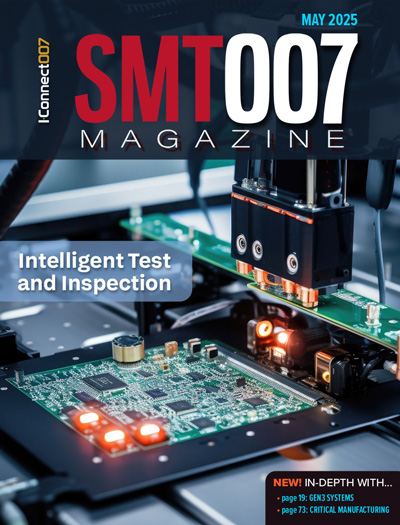-

-
News
News Highlights
- Books
Featured Books
- smt007 Magazine
Latest Issues
Current Issue
What's Your Sweet Spot?
Are you in a niche that’s growing or shrinking? Is it time to reassess and refocus? We spotlight companies thriving by redefining or reinforcing their niche. What are their insights?

Moving Forward With Confidence
In this issue, we focus on sales and quoting, workforce training, new IPC leadership in the U.S. and Canada, the effects of tariffs, CFX standards, and much more—all designed to provide perspective as you move through the cloud bank of today's shifting economic market.

Intelligent Test and Inspection
Are you ready to explore the cutting-edge advancements shaping the electronics manufacturing industry? The May 2025 issue of SMT007 Magazine is packed with insights, innovations, and expert perspectives that you won’t want to miss.
- Articles
- Columns
- Links
- Media kit
||| MENU - smt007 Magazine
Excerpt—The Printed Circuit Assembler’s Guide to... SMT Inspection: Today, Tomorrow, and Beyond, Chapter 4
May 12, 2021 | Brent Fischthal, Koh Young AmericaEstimated reading time: 3 minutes
Chapter 4: A Vision of the Factory of the Future
Intelligent software solutions can help customers analyze and optimize the production process by managing process data from connected SPI and AOI systems to speed the arrival of the 4th Industrial Revolution and perhaps even offer a path to the autonomous manufacturing future some are calling Industry 5.0.
So, What Would the Ideal Smart Factory Solution Suite Look Like?
Industry 4.0, or smart manufacturing, should represent a revolution in process optimization that ensures the highest standards of quality and reliability on the SMT line and beyond. The software should collect inspection and measurement data from all equipment into a central repository for defect detection, real-time optimization, enhanced and accelerated decision making, and detailed traceability. Once the data is collected and analyzed, the software can be used to improve metrics, increase board quality, and lower costs by eliminating waste, variance, false calls, and escapes.
The software should include multiple complementary software modules for extensive data collection, management and analysis, as well as a comprehensive set of optimization solutions that would integrate 3D SPI and 3D AOI systems to provide the power of connectivity and pave the way for Industry 4.0 with smart, data-driven analytics.
Using the right 3D measurement technology will deliver accurate measurement data to help manufacturers streamline the SMT line and realize a zero defect production environment. The ability to generate reliable measurement data has given rise to the creation of measurement-based analysis and optimization solutions. With quality control capabilities and a full lineup of integrated inspection systems, the ideal software suite should tie everything together: SPI, AOI and other production machines, all supported by AI-powered analysis for fully automated control that boosts productivity and minimizes costs.
Focus on Data Management
Processed data is information, analyzed data is insight; data management modules provide the key to efficient production and high standards of quality and reliability.
Realizing a smart factory means taking a practical approach to process and systems while examining areas to improve productivity. Using real 3D measurement data generated during inspection helps manufacturers define inefficiencies and boost line efficiency. For example, a “Library Manager” module can simultaneously deploy programs and inspection conditions across multiple lines to enhance productivity and data integrity with consistent performance.
Operators can further improve line maintenance with real-time monitoring where the system instantly displays relevant process parameters to remote locations for immediate analysis and action. Adopting multi-point inspection from SPI (post-print), pre-reflow AOI (post-placement), and post-reflow AOI systems collects, manages, and monitors real data, so operators can determine actionable insights to optimize processes.
Suggested Software Modules
Library Manager
- Deploys optimized programs and conditions to all inspection machines to seamlessly program, deploy, move, delete, compare, and back up programs for all connected machines
- Offers traceable management of changes via user-level identification
- Maximizes productivity by centralizing and optimizing all programming resources in a single management system
Multi-point Connectivity
- Connects all inspection systems within a line to consolidate inspection results for review to find correlations between processes
- Streamlines production with regular data-based review, diagnosis and optimization of printing, pick-and-place and reflow processes via linked inspection results
- Provides review of SPI, pre- and post-AOI images, trend charts, and inspection results to correlate printing, placement, and reflow data
Real-time Monitoring
- Displays real-time statistics so operators can monitor line performance in real time
- Enables a single operator to monitor multiple lines and dozens of machines, which allows operators to focus on other critical line tasks
- Tracks various machines in the factory, showing the best performing machine yield and top five defects list, plus charts reflecting yield, availability, X-bar, and sigma all on one page
Focus on Data Analysis
The strength of the ideal smart factory software suite will exist in its analytical power. A statistical process control module can provide a straightforward visualization of real-time production and inspection results, including configurable charts for user-specific parameters. Users can identify the exact defect origin by checking false calls and NG (no good) parts from the dashboard, as well as evaluate and optimize default settings by comparing actual results with average, minimum, and maximum values. For example, if the process is stable, operators can further tighten the tolerances to prevent escapes.
To download this free eBook, published by I-Connect007, click here.
To view the entire I-Connect007 eBook library, click here.


